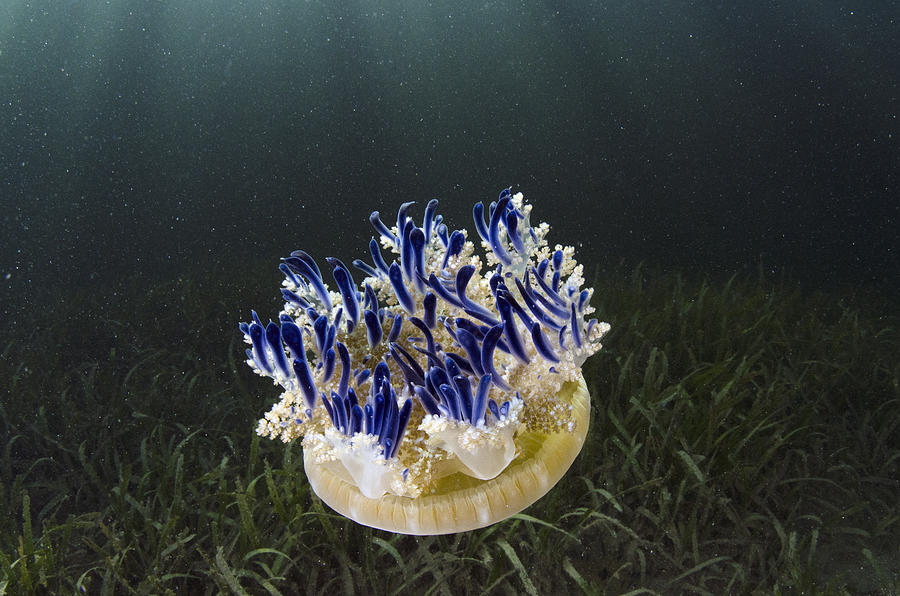
Although mild, their stings can cause redness and welting. But both species are distributed worldwide. xmanchana in Paul Humann’s Reef Creature Identification – Florida, Caribbean Bahamas, although its bands are blue-green. This one, with brown bands, most resembles the C. (common jellyfish) to the most exotic such as the Cassiopeia xamachana. 1) The bell-shaped jellyfish have fallen. The colors can vary depending on the zooxanthellae. The Aquarium of Seville presents the most intimate jellyfish exhibition of recent. (Your sentences dont have to relate to the cassiopeia jellyfish.) Scintillating Sentences. The zoox provide them with both nutrition and their coloration. ZOOX-ENDORSED But they are blessed with the presence of zooxanthellae – the dinoflagellates that power-feed corals – in their tissues, and pass the time extending their short tentacles upward to facilitate the zooxanthellae’s photosynthetic services. They do use their tentacles – which offer only a mild sting – to catch plankton and other small invertebrates that pass by. NORMALLY ON THE BOTTOM Although they can swim, upside down jellies spend most of their time lying on their backs in shallow waters – mostly mangrove inlets – catching rays. Righting itself, it drifts downward… …to resume its natural position. TWO DENIZENS OF NOTE IN THE MANGROVE ENVIRONMENT are Cassiopea fronosa and Cassiopea xmanchana, both better known by the common name “Upside Down Jellyfish” (as we pseudo marine naturalist know, they should be called sea jellies but all the sources I.D. Keep groups in a well-established tank with. So here at the surface is an upside down jellyfish …upside down. Cassiopeia xamachana Upside Down Jellyfish are found in warmer coastal waters like the Caribbean and Atlantic.
Cassiopeia jelly fish how to#
Those bombs release a skin-irritating venom when they make contact with a passing swimmer.Īs for how to avoid being stung, researchers are still investigating whether the jellies release the venom more at certain times of the day or in response to certain types of disturbances.During mangrove tours where you get out of the kayak, some wiseguy always reaches down and scoops one up to show it off. The Upside-Down Jellyfish is an unusual jellyfish that spends most of its time resting on its back over the sediment, giving it an upside-down appearance. They are found in warmer coastal regions around. For these algal cells to receive enough sunlight to photosynthesize, the Cassiopea. The jellyfish deploy cellular bombs armed with stinging cells called nematocytes, according to their study. Upside-down Jellyfish (Cassiopea) is a genus of jellyfish and the only members of the family Cassiopeidae. These algal cells, or microscopic seaweeds, colonize what is typically considered the underside of a jellyfish. A beautiful brown and white jelly fish found by the thousands among the roots of mangroves in the southern Gulf of Mexico, Caribbean, and other tropical waters. “You start to feel this tingling … More than just itchiness, like when an itch turns into a painful discomfort,” Cheryl Ames, a museum research associate and an associate professor of applied marine biology at Tohoku University in Japan, explained to Live Science.Īmes and her colleagues believe they have figured out why this happens their work was published today in the journal Communications Biology. When snorkelers are in those areas, they sometimes develop a strange itching sensation. The jellyfish, formally known as Cassiopea xamachana, have a weird, plant-like appearance and they typically are stuck to the ocean’s floor.Īccording to the Monterey Bay Aquarium, these jellyfish are typically found living in the mangrove forests and lagoons of southern Florida, Hawaii, the Indo-Pacific Ocean and the Caribbean. During mangrove tours where you get out of the kayak, some wiseguy always reaches down and scoops one up to show it off. Upside-down jellyfish on the ocean floor release venom-filled blobs of mucus, which can sting nearby swimmers, new research reveals.



World’s largest subterranean fish discovered in Indian cave It was first described by the American marine biologist Henry Bryant Bigelow in 1892. It is found in warm parts of the western Atlantic Ocean, the Caribbean Sea, and the Gulf of Mexico. Antarctica temperatures reach 69 degrees for the first time everĬlimate change could destroy half of Earth's animal and plant species in the next 50 years Cassiopea xamachana, commonly known as the upside-down jellyfish, is a species of jellyfish in the family Cassiopeidae. Also known as the upside-down jellyfish or mangrove jelly, this strange creature is very different.


 0 kommentar(er)
0 kommentar(er)
